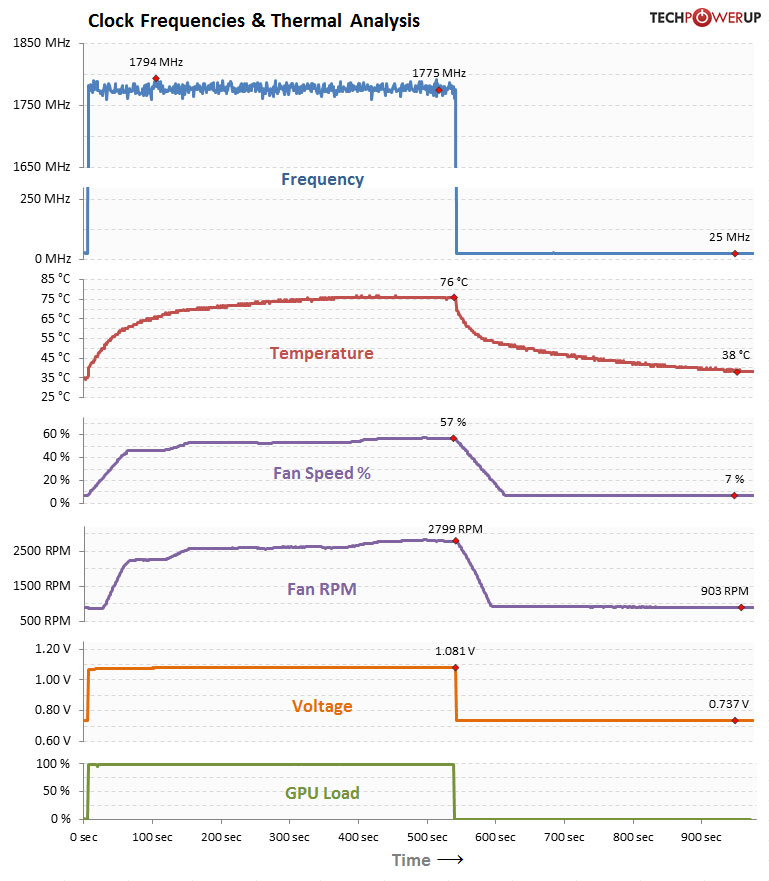 553
553
AMD Radeon VII 16 GB Review
Value & Conclusion »Clock Speeds
For this test, we first let the card sit in idle to reach thermal equilibrium. Next, we start a constant 100% gaming load, recording several important parameters while the test is running. This shows you the thermal behavior of the card and how the fans ramp up as temperatures increase. Once the temperatures are stable (no increase for two minutes), we stop the load and record how the card cools down over time.
Clock Profiles
Modern graphics cards have several clock profiles that are selected to balance power draw and performance requirements.The following table lists the clock settings for important performance scenarios and the GPU voltage that is used in those states.
| GPU Clock | Memory Clock | GPU Voltage | |
|---|---|---|---|
| Desktop | 25 MHz | 350 MHz | 0.713 V |
| Multi-Monitor | 25 MHz | 350 MHz | 0.712 V |
| Blu-ray Playback | 21 MHz | 350 MHz | 0.713 V |
| 3D Load | 1766-1794 MHz | 1000 MHz | 1.068-1.081 V |
Mar 9th, 2025 18:31 EDT
change timezone
Latest GPU Drivers
New Forum Posts
- I need a BIOS for the "Rx580 8gb" chip 215-0876406 (3)
- 9070 XT - 2x HDMI high refresh displays (144 and 120 Hz) not working (3)
- What's your latest tech purchase? (23263)
- A Final Fantasy IX Reminiscence - My love letter and homage to one of the best stories ever told (71)
- RTX 3060 black screens on load and light browsing even after RMA (22)
- SLI with different cards (3768)
- NVCleanstall loading driver versions failed (4)
- What are you playing? (23114)
- Fun with SBCs (0)
- RX 9070 availability (90)
Popular Reviews
- Sapphire Radeon RX 9070 XT Nitro+ Review - Beating NVIDIA
- ASUS Radeon RX 9070 TUF OC Review
- XFX Radeon RX 9070 XT Mercury OC Magnetic Air Review
- NVIDIA GeForce RTX 5070 Founders Edition Review
- Corsair Vengeance RGB CUDIMM DDR5-8800 48 GB CL42 Review
- MSI MAG B850 Tomahawk Max Wi-Fi Review
- AMD Ryzen 7 9800X3D Review - The Best Gaming Processor
- AMD Radeon RX 9070 Series Technical Deep Dive
- ASUS GeForce RTX 5070 Ti TUF OC Review
- MSI GeForce RTX 5070 Ti Gaming Trio OC+ Review
Controversial News Posts
- NVIDIA GeForce RTX 50 Cards Spotted with Missing ROPs, NVIDIA Confirms the Issue, Multiple Vendors Affected (513)
- AMD Plans Aggressive Price Competition with Radeon RX 9000 Series (277)
- AMD Radeon RX 9070 and 9070 XT Listed On Amazon - One Buyer Snags a Unit (261)
- AMD RDNA 4 and Radeon RX 9070 Series Unveiled: $549 & $599 (259)
- AMD Mentions Sub-$700 Pricing for Radeon RX 9070 GPU Series, Looks Like NV Minus $50 Again (248)
- NVIDIA Investigates GeForce RTX 50 Series "Blackwell" Black Screen and BSOD Issues (244)
- AMD Radeon RX 9070 and 9070 XT Official Performance Metrics Leaked, +42% 4K Performance Over Radeon RX 7900 GRE (195)
- AMD Radeon RX 9070-series Pricing Leaks Courtesy of MicroCenter (158)